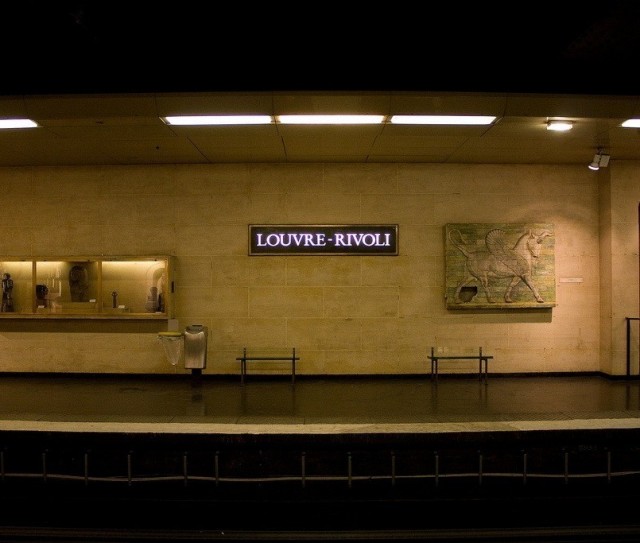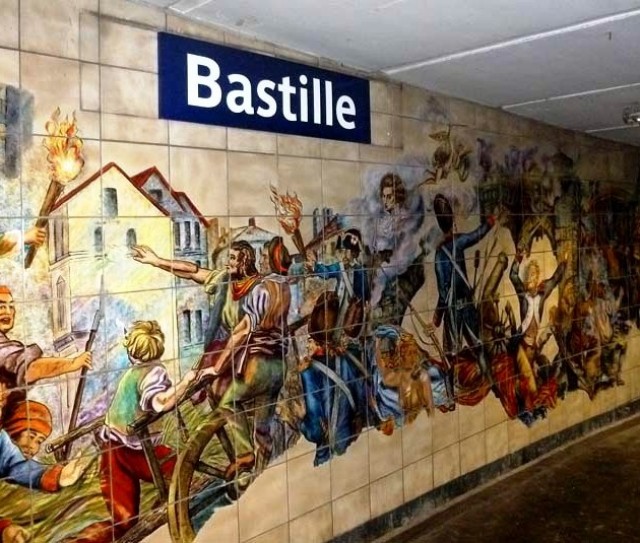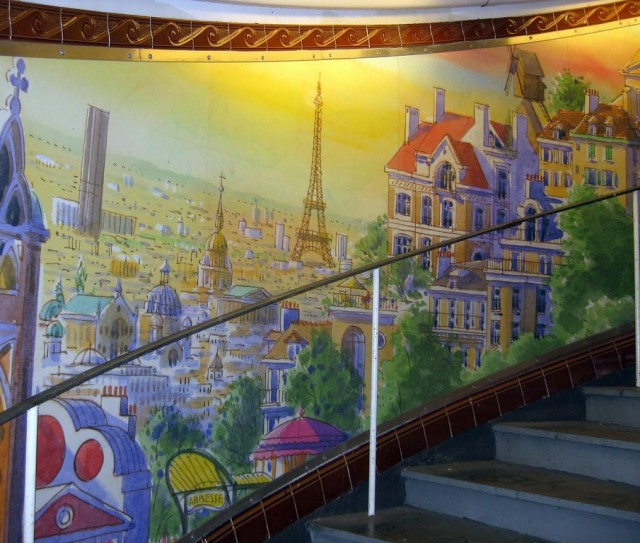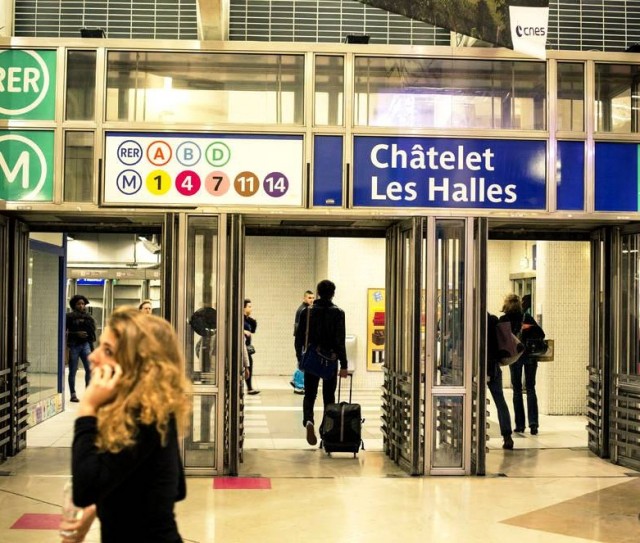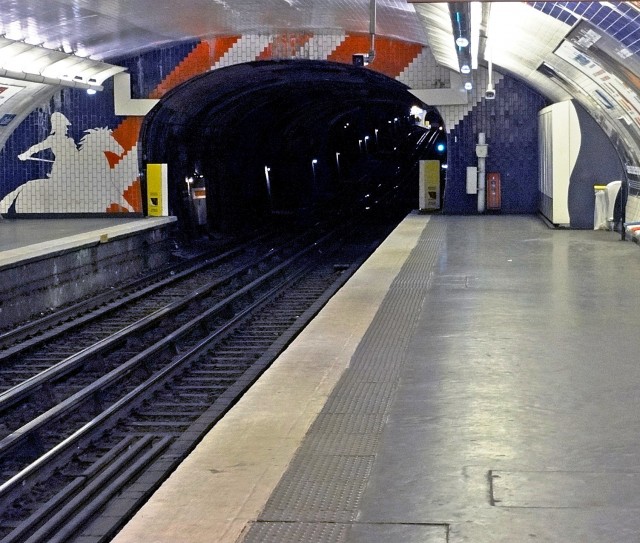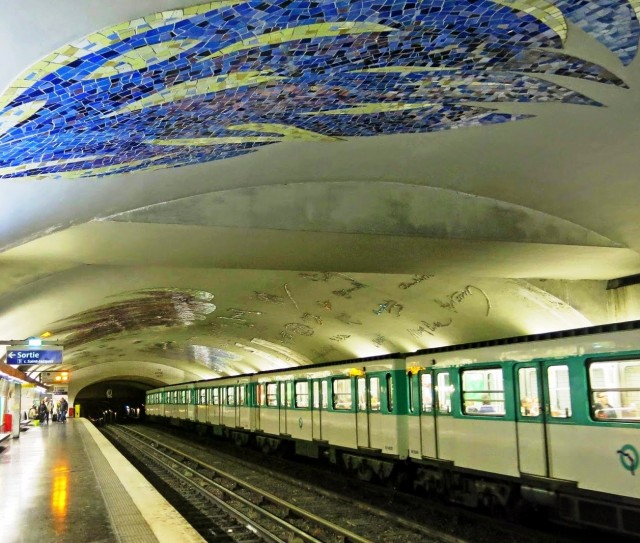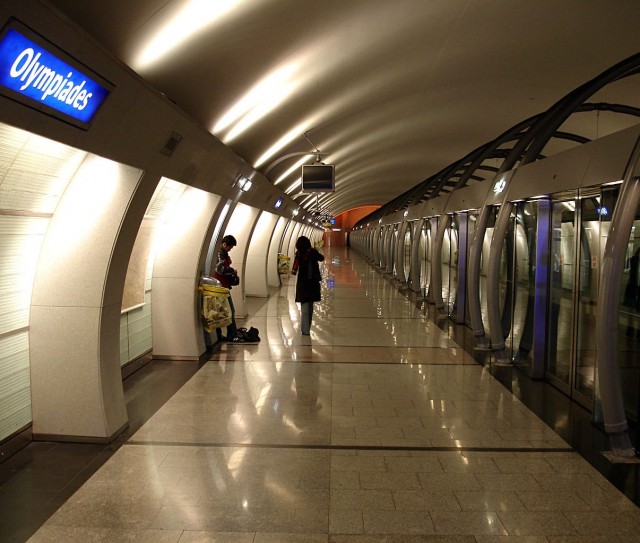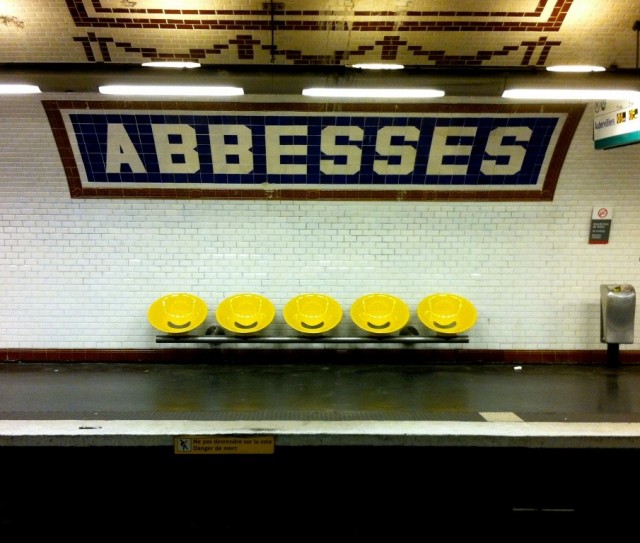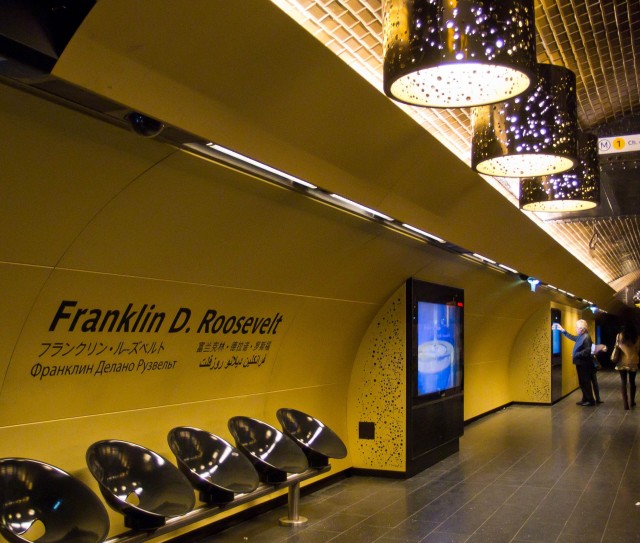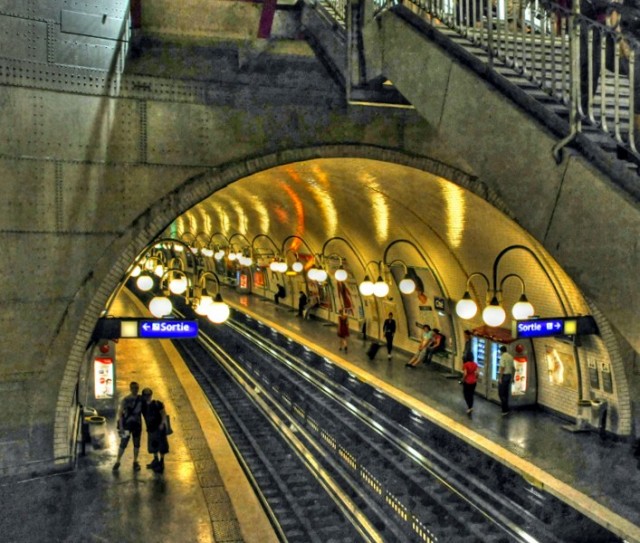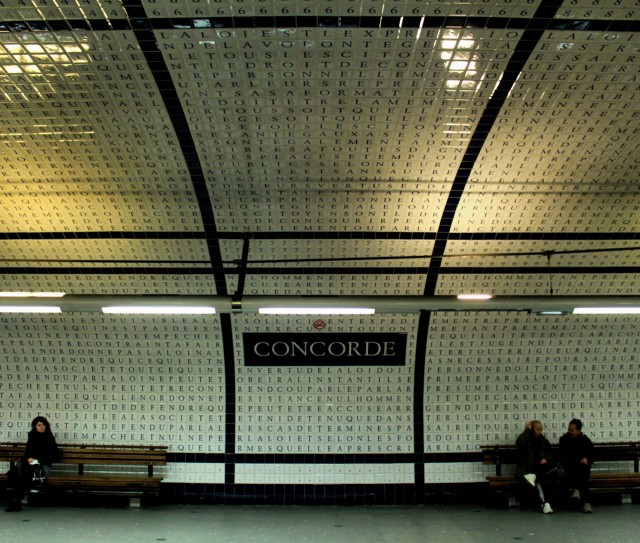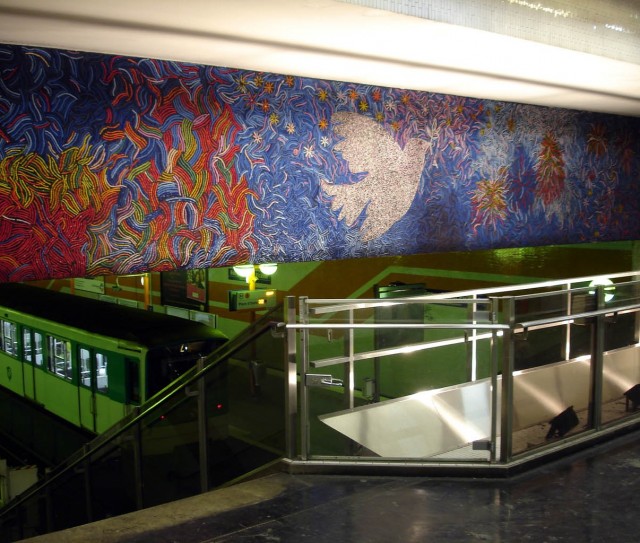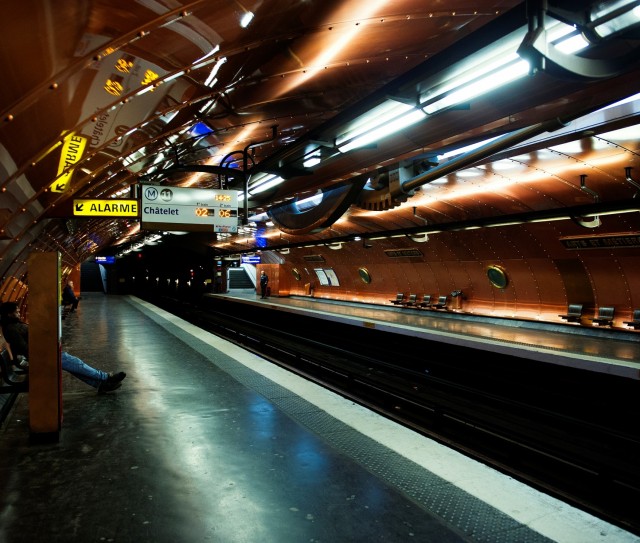- Ligne 1
- La Défense
- Esplanade de La Défense
-
Pont de Neuilly
- Les Sablons
- Porte Maillot
- Argentine
- Charles de Gaulle Étoile
- George V
- Franklin D. Roosevelt
- Champs-Élysées Clemenceau
- Concorde
- Tuileries
- Palais Royal Musée du Louvre
- Louvre Rivoli
- Châtelet
- Hôtel de Ville
- St-Paul
- Bastille
- Gare de Lyon
- Reuilly-Diderot
- Nation
- Porte de Vincennes
- Saint-Mandé
- Bérault
- Château de Vincennes
- Ligne 2
- Porte Dauphine
- Victor Hugo
- Charles de Gaulle Étoile
- Ternes
- Courcelles
- Monceau
- Villiers
- Rome
- Place de Clichy
- Blanche
- Pigalle
- Anvers
- Barbès Rochechouart
- La Chapelle
- Stalingrad
- Jaurès
- Colonel Fabien
- Belleville
- Couronnes
- Ménilmontant
- Père Lachaise
- Philippe Auguste
- Alexandre Dumas
- Avron
- Nation
- Ligne 3
- Pont de Levallois - Bécon
- Anatole France
- Louise Michel
- Porte de Champerret
- Pereire
- Wagram
- Malesherbes
- Villiers
- Europe
- Saint-Lazare
- Havre - Caumartin
- Opéra
- Quatre Septembre
- Bourse
- Sentier
- Réaumur-Sébastopol
- Arts et Métiers
- Temple
- République
- Parmentier
- Rue Saint-Maur
- Père Lachaise
- Gambetta
- Porte de Bagnolet
- Gallieni
- Ligne 3bis
- Gambetta
- Pelleport
- Saint-Fargeau
- Porte des Lilas
- Ligne 4
- Porte de Clignancourt
- Simplon
- Marcadet-Poissonniers
- Château Rouge
- Barbès-Rochechouart
- Gare du Nord
- Gare de l'Est
- Château d'Eau
- Strasbourg – Saint-Denis
- Réaumur-Sébastopol
- Étienne Marcel
- Les Halles
- Châtelet
- Cité
- Saint-Michel
- Odéon
- Saint-Germain des-Prés
- Saint-Sulpice
- Saint-Placide
- Montparnasse Bienvenüe
- Vavin
- Raspail
- Denfert-Rochereau
- Mouton-Duvernet
- Alésia
- Porte d'Orléans
- Mairie de Montrouge
- Barbara
- Bagneux-Lucie Aubrac
- Ligne 5
- Bobigny Pablo Picasso
- Bobigny - Pantin Raymond Queneau
- Église de Pantin
- Hoche
- Porte de Pantin
- Ourcq
- Laumière
- Jaurès
- Stalingrad
- Gare du Nord
- Gare de l'Est
- Jacques Bonsergent
- République
- Oberkampf
- Richard Lenoir
- Bréguet Sabin
- Bastille
- Quai de la Rapée
- Gare d'Austerlitz
- Saint-Marcel
- Campo-Formio
- Place d'Italie
- Ligne 6
- Charles de Gaulle Étoile
- Kléber
- Boissière
- Trocadéro
- Passy
- Bir-Hakeim
- Dupleix
- La Motte-Picquet – Grenelle
- Cambronne
- Sèvres-Lecourbe
- Pasteur
- Montparnasse Bienvenüe
- Edgar Quinet
- Raspail
- Denfert-Rochereau
- Saint-Jacques
- Glacière
- Corvisart
- Place d'Italie
- Nationale
- Chevaleret
- Quai de la Gare
- Bercy
- Dugommier
- Daumesnil
- Bel-Air
- Picpus
- Nation
- Ligne 7
- La Courneuve - 8 Mai 1945
- Fort d'Aubervilliers
- Aubervilliers-Pantin Quatre Chemins
- Porte de la Villette
- Corentin Cariou
- Crimée
- Riquet
- Stalingrad
- Louis Blanc
- Château Landon
- Gare de l'Est
- Poissonnière
- Cadet
- Le Peletier
- Chaussée d'Antin - La Fayette
- Opéra
- Pyramides
- Palais Royal-Musée du Louvre
- Pont Neuf
- Châtelet
- Pont Marie
- Sully - Morland
- Jussieu
- Place Monge
- Censier - Daubenton
- Les Gobelins
- Place d'Italie
- Tolbiac
- Maison Blanche
- Maison Blanche
- Porte d'Italie
- Porte de Choisy
- Porte d'Ivry
- Pierre et Marie Curie
- Mairie d'Ivry
- Maison Blanche
- Le Kremlin-Bicêtre
- Villejuif - Léo Lagrange
- Villejuif - Paul Vaillant-Couturier
- Villejuif - Louis Aragon
- Ligne 7bis
- Louis Blanc
- Jaurès
- Bolivar
- Buttes Chaumont
- Botzaris
- Place des Fêtes
- Pré St-Gervais
- Danube
- Ligne 8
- Balard
- Lourmel
- Boucicaut
- Félix Faure
- Commerce
- La Motte-Picquet Grenelle
- École Militaire
- La Tour-Maubourg
- Invalides
- Concorde
- Madeleine
- Opéra
- Richelieu – Drouot
- Grands Boulevards
- Bonne Nouvelle
- Strasbourg Saint-Denis
- République
- Filles du Calvaire
- Saint-Sébastien Froissart
- Chemin Vert
- Bastille
- Ledru-Rollin
- Faidherbe – Chaligny
- Reuilly-Diderot
- Montgallet
- Daumesnil
- Michel Bizot
- Porte Dorée
- Porte de Charenton
- Liberté
- Charenton – Écoles
- École Vétérinaire de Maisons-Alfort
- Maisons-Alfort – Stade
- Maisons-Alfort Les Juilliottes
- Créteil – L'Échat
- Créteil – Université
- Créteil – Préfecture
- Créteil – Pointe du Lac
- Ligne 9
- Pont de Sèvres
- Billancourt
- Marcel Sembat
- Porte de Saint-Cloud
- Exelmans
- Michel-Ange Molitor
- Michel-Ange - Auteuil
- Jasmin
- Ranelagh
- La Muette
- Rue de la Pompe
- Trocadéro
- Iéna
- Alma - Marceau
- Franklin D. Roosevelt
- Saint-Philippe du Roule
- Miromesnil
- Saint-Augustin
- Havre Caumartin
- Chaussée d'Antin La Fayette
- Richelieu Drouot
- Grands Boulevards
- Bonne Nouvelle
- Strasbourg Saint-Denis
- République
- Oberkampf
- Saint-Ambroise
- Voltaire
- Charonne
- Rue des Boulets
- Nation
- Buzenval
- Maraîchers
- Porte de Montreuil
- Robespierre
- Croix de Chavaux
- Mairie de Montreuil
- Ligne 10
- Boulogne Pont de St-Cloud
- Boulogne – Jean Jaurès
- Michel-Ange – Molitor
- Chardon Lagache
- Mirabeau
- Javel André Citroën
- Charles Michels
- Avenue Émile-Zola
- La Motte-Picquet-Grenelle
- Ségur
- Duroc
- Vaneau
- Sèvres-Babylone
- Mabillon
- Odéon
- Cluny La Sorbonne
- Maubert Mutualité
- Cardinal Lemoine
- Jussieu
- Gare d'Austerlitz
- Boulogne – Jean Jaurès
- Porte d'Auteuil
- Michel-Ange – Auteuil
- Église d'Auteuil
- Javel – André Citroën
- Ligne 11
- Mairie des Lilas
- Porte des Lilas
- Télégraphe
- Place des Fêtes
- Jourdain
- Pyrénées
- Belleville
- Goncourt
- République
- Arts et Métiers
- Rambuteau
- Hôtel de Ville
- Châtelet
- Ligne 12
- Mairie d'Aubervilliers
- Aimé Césaire
- Front Populaire
- Porte de la Chapelle
- Marx Dormoy
- Marcadet Poissonniers
- Jules Joffrin
- Lamarck Caulaincourt
- Abbesses
- Pigalle
- Saint-Georges
- Notre-Dame de-Lorette
- Trinité d'Estienne d'Orves
- Saint-Lazare
- Madeleine
- Concorde
- Assemblée Nationale
- Solférino
- Rue du Bac
- Sèvres Babylone
- Rennes
- Notre-Dame-des-Champs
- Montparnasse Bienvenüe
- Falguière
- Pasteur
- Volontaires
- Vaugirard
- Convention
- Porte de Versailles
- Corentin Celton
- Mairie d'Issy
- Ligne 13
- La Fourche
- Place de Clichy
- Liège
- Saint-Lazare
- Miromesnil
- Champs-Élysées – Clemenceau
- Invalides
- Varenne
- Saint-François Xavier
- Duroc
- Montparnasse Bienvenüe
- Gaîté
- Pernety
- Plaisance
- Porte de Vanves
- Malakoff Plateau de Vanves
- Malakoff Rue Étienne Dolet
- Châtillon - Montrouge
- Saint-Denis-Université
- Basilique de Saint-Denis
- Saint-Denis Porte de Paris
- Carrefour Pleyel
- Mairie de Saint-Ouen
- Garibaldi
- Porte de Saint-Ouen
- Guy Môquet
- La Fourche
- Asnières - Gennevilliers - Les Courtilles
- Les Agnettes
- Gabriel Péri
- Mairie de Clichy
- Porte de Clichy
- Brochant
- La Fourche
- Ligne 14
- Mairie de Saint-Ouen
- Saint-Ouen
- Porte de Clichy
- Pont Cardinet
- Saint-Lazare
- Madeleine
- Pyramides
- Châtelet
- Gare de Lyon
- Bercy
- Cour Saint-Émilion
- Bibliothèque François Mitterrand
- Olympiades
- No matches
- Ligne 1
- La Défense
- Esplanade de La Défense
-
Pont de Neuilly
- Les Sablons
- Porte Maillot
- Argentine
- Charles de Gaulle Étoile
- George V
- Franklin D. Roosevelt
- Champs-Élysées Clemenceau
- Concorde
- Tuileries
- Palais Royal Musée du Louvre
- Louvre Rivoli
- Châtelet
- Hôtel de Ville
- St-Paul
- Bastille
- Gare de Lyon
- Reuilly-Diderot
- Nation
- Porte de Vincennes
- Saint-Mandé
- Bérault
- Château de Vincennes
- Ligne 2
- Porte Dauphine
- Victor Hugo
- Charles de Gaulle Étoile
- Ternes
- Courcelles
- Monceau
- Villiers
- Rome
- Place de Clichy
- Blanche
- Pigalle
- Anvers
- Barbès Rochechouart
- La Chapelle
- Stalingrad
- Jaurès
- Colonel Fabien
- Belleville
- Couronnes
- Ménilmontant
- Père Lachaise
- Philippe Auguste
- Alexandre Dumas
- Avron
- Nation
- Ligne 3
- Pont de Levallois - Bécon
- Anatole France
- Louise Michel
- Porte de Champerret
- Pereire
- Wagram
- Malesherbes
- Villiers
- Europe
- Saint-Lazare
- Havre - Caumartin
- Opéra
- Quatre Septembre
- Bourse
- Sentier
- Réaumur-Sébastopol
- Arts et Métiers
- Temple
- République
- Parmentier
- Rue Saint-Maur
- Père Lachaise
- Gambetta
- Porte de Bagnolet
- Gallieni
- Ligne 3bis
- Gambetta
- Pelleport
- Saint-Fargeau
- Porte des Lilas
- Ligne 4
- Porte de Clignancourt
- Simplon
- Marcadet-Poissonniers
- Château Rouge
- Barbès-Rochechouart
- Gare du Nord
- Gare de l'Est
- Château d'Eau
- Strasbourg – Saint-Denis
- Réaumur-Sébastopol
- Étienne Marcel
- Les Halles
- Châtelet
- Cité
- Saint-Michel
- Odéon
- Saint-Germain des-Prés
- Saint-Sulpice
- Saint-Placide
- Montparnasse Bienvenüe
- Vavin
- Raspail
- Denfert-Rochereau
- Mouton-Duvernet
- Alésia
- Porte d'Orléans
- Mairie de Montrouge
- Barbara
- Bagneux-Lucie Aubrac
- Ligne 5
- Bobigny Pablo Picasso
- Bobigny - Pantin Raymond Queneau
- Église de Pantin
- Hoche
- Porte de Pantin
- Ourcq
- Laumière
- Jaurès
- Stalingrad
- Gare du Nord
- Gare de l'Est
- Jacques Bonsergent
- République
- Oberkampf
- Richard Lenoir
- Bréguet Sabin
- Bastille
- Quai de la Rapée
- Gare d'Austerlitz
- Saint-Marcel
- Campo-Formio
- Place d'Italie
- Ligne 6
- Charles de Gaulle Étoile
- Kléber
- Boissière
- Trocadéro
- Passy
- Bir-Hakeim
- Dupleix
- La Motte-Picquet – Grenelle
- Cambronne
- Sèvres-Lecourbe
- Pasteur
- Montparnasse Bienvenüe
- Edgar Quinet
- Raspail
- Denfert-Rochereau
- Saint-Jacques
- Glacière
- Corvisart
- Place d'Italie
- Nationale
- Chevaleret
- Quai de la Gare
- Bercy
- Dugommier
- Daumesnil
- Bel-Air
- Picpus
- Nation
- Ligne 7
- La Courneuve - 8 Mai 1945
- Fort d'Aubervilliers
- Aubervilliers-Pantin Quatre Chemins
- Porte de la Villette
- Corentin Cariou
- Crimée
- Riquet
- Stalingrad
- Louis Blanc
- Château Landon
- Gare de l'Est
- Poissonnière
- Cadet
- Le Peletier
- Chaussée d'Antin - La Fayette
- Opéra
- Pyramides
- Palais Royal-Musée du Louvre
- Pont Neuf
- Châtelet
- Pont Marie
- Sully - Morland
- Jussieu
- Place Monge
- Censier - Daubenton
- Les Gobelins
- Place d'Italie
- Tolbiac
- Maison Blanche
- Ligne 7/1
- Maison Blanche
- Porte d'Italie
- Porte de Choisy
- Porte d'Ivry
- Pierre et Marie Curie
- Mairie d'Ivry
- Ligne 7/2
- Maison Blanche
- Le Kremlin-Bicêtre
- Villejuif - Léo Lagrange
- Villejuif - Paul Vaillant-Couturier
- Villejuif - Louis Aragon
- Ligne 7bis
- Louis Blanc
- Jaurès
- Bolivar
- Buttes Chaumont
- Botzaris
- Place des Fêtes
- Pré St-Gervais
- Danube
- Ligne 8
- Balard
- Lourmel
- Boucicaut
- Félix Faure
- Commerce
- La Motte-Picquet Grenelle
- École Militaire
- La Tour-Maubourg
- Invalides
- Concorde
- Madeleine
- Opéra
- Richelieu – Drouot
- Grands Boulevards
- Bonne Nouvelle
- Strasbourg Saint-Denis
- République
- Filles du Calvaire
- Saint-Sébastien Froissart
- Chemin Vert
- Bastille
- Ledru-Rollin
- Faidherbe – Chaligny
- Reuilly-Diderot
- Montgallet
- Daumesnil
- Michel Bizot
- Porte Dorée
- Porte de Charenton
- Liberté
- Charenton – Écoles
- École Vétérinaire de Maisons-Alfort
- Maisons-Alfort – Stade
- Maisons-Alfort Les Juilliottes
- Créteil – L'Échat
- Créteil – Université
- Créteil – Préfecture
- Créteil – Pointe du Lac
- Ligne 9
- Pont de Sèvres
- Billancourt
- Marcel Sembat
- Porte de Saint-Cloud
- Exelmans
- Michel-Ange Molitor
- Michel-Ange - Auteuil
- Jasmin
- Ranelagh
- La Muette
- Rue de la Pompe
- Trocadéro
- Iéna
- Alma - Marceau
- Franklin D. Roosevelt
- Saint-Philippe du Roule
- Miromesnil
- Saint-Augustin
- Havre Caumartin
- Chaussée d'Antin La Fayette
- Richelieu Drouot
- Grands Boulevards
- Bonne Nouvelle
- Strasbourg Saint-Denis
- République
- Oberkampf
- Saint-Ambroise
- Voltaire
- Charonne
- Rue des Boulets
- Nation
- Buzenval
- Maraîchers
- Porte de Montreuil
- Robespierre
- Croix de Chavaux
- Mairie de Montreuil
- Ligne 10
- Boulogne Pont de St-Cloud
- Boulogne – Jean Jaurès
- Michel-Ange – Molitor
- Chardon Lagache
- Mirabeau
- Javel André Citroën
- Charles Michels
- Avenue Émile-Zola
- La Motte-Picquet-Grenelle
- Ségur
- Duroc
- Vaneau
- Sèvres-Babylone
- Mabillon
- Odéon
- Cluny La Sorbonne
- Maubert Mutualité
- Cardinal Lemoine
- Jussieu
- Gare d'Austerlitz
- Ligne 10/1
- Boulogne – Jean Jaurès
- Porte d'Auteuil
- Michel-Ange – Auteuil
- Église d'Auteuil
- Javel – André Citroën
- Ligne 11
- Mairie des Lilas
- Porte des Lilas
- Télégraphe
- Place des Fêtes
- Jourdain
- Pyrénées
- Belleville
- Goncourt
- République
- Arts et Métiers
- Rambuteau
- Hôtel de Ville
- Châtelet
- Ligne 12
- Mairie d'Aubervilliers
- Aimé Césaire
- Front Populaire
- Porte de la Chapelle
- Marx Dormoy
- Marcadet Poissonniers
- Jules Joffrin
- Lamarck Caulaincourt
- Abbesses
- Pigalle
- Saint-Georges
- Notre-Dame de-Lorette
- Trinité d'Estienne d'Orves
- Saint-Lazare
- Madeleine
- Concorde
- Assemblée Nationale
- Solférino
- Rue du Bac
- Sèvres Babylone
- Rennes
- Notre-Dame-des-Champs
- Montparnasse Bienvenüe
- Falguière
- Pasteur
- Volontaires
- Vaugirard
- Convention
- Porte de Versailles
- Corentin Celton
- Mairie d'Issy
- Ligne 13
- La Fourche
- Place de Clichy
- Liège
- Saint-Lazare
- Miromesnil
- Champs-Élysées – Clemenceau
- Invalides
- Varenne
- Saint-François Xavier
- Duroc
- Montparnasse Bienvenüe
- Gaîté
- Pernety
- Plaisance
- Porte de Vanves
- Malakoff Plateau de Vanves
- Malakoff Rue Étienne Dolet
- Châtillon - Montrouge
- Ligne 13/1
- Saint-Denis-Université
- Basilique de Saint-Denis
- Saint-Denis Porte de Paris
- Carrefour Pleyel
- Mairie de Saint-Ouen
- Garibaldi
- Porte de Saint-Ouen
- Guy Môquet
- La Fourche
- Ligne 13/2
- Asnières - Gennevilliers - Les Courtilles
- Les Agnettes
- Gabriel Péri
- Mairie de Clichy
- Porte de Clichy
- Brochant
- La Fourche
- Ligne 14
- Mairie de Saint-Ouen
- Saint-Ouen
- Porte de Clichy
- Pont Cardinet
- Saint-Lazare
- Madeleine
- Pyramides
- Châtelet
- Gare de Lyon
- Bercy
- Cour Saint-Émilion
- Bibliothèque François Mitterrand
- Olympiades
- No matches
Copyright © 2026 Discover Ukraine LLC.
Info
The Paris Metro proudly stands as one of the world's oldest metro systems and is a cherished emblem of France. Its inauguration was a grand spectacle, aligning with the Universal Exhibition of 1900. This venerable metro ranks among the top ten in terms of ridership and boasts an impressive eleventh position in terms of total line length when compared to its global counterparts.
The initial phase of the Paris metro featured two lines, with the primary line comprising ten stations, serving as a vital artery that traversed the heart of the French capital. A second line of three stations connected the Bois de Boulogne to the Place des Stars. This pioneering endeavor, over a century old, has evolved into a robust network featuring fourteen main lines and two branches, with the majority operating underground. The metro derived its name from its original moniker, "chemin de fer métropolitain," from which the terms "metro" and "metropolitan" originated.
Today, the Paris Metro reigns as the favored, convenient, and economically sound mode of public transportation in the city of lights. An astounding four million passengers embark on its journey daily. This expansive metro system connects the city center to the farthest reaches of Paris, encompassing all its vibrant districts and extending into select suburbs, including Montreuil, Créteil, Saint-Denis, among others. Notably, the metro network serves all seven of Paris' central train stations, including the bustling Gare du Nord, which provides commuter trains connecting to Paris Charles de Gaulle Airport. Moreover, these metro stations are strategically positioned in proximity to many of Paris' iconic attractions, such as the Eiffel Tower, the Louvre, Notre Dame Cathedral, the Orsay Museum, and the Sacré-Coeur Basilica.
Operated by RATP, the Paris Metro, in tandem with buses, trams, commuter trains, and river transport, creates a unified public transport network within the French capital, segmented into tariff zones. The fare structure hinges on the number of zones traversed. Traveling solely by metro incurs a ticket price equivalent to that of the first zone, fixed at 1.90 EUR. When transferring to RER commuter trains, passengers must acquire a ticket valid for the corresponding zone.
Paris metro stations bear distinct markings depending on their opening date, featuring either an M logo or the vintage "metropolitain" and "metro" inscriptions. Distinguishing characteristics include ornate pavilions and arches at the entrances of the oldest lines. Due to their shallow depth, many stations lack elevators or escalators. The interior design of the Paris metro prioritizes functionality over extravagance. Classic white ceramic tiles adorn most stations, but some stations deserve special mention for their unique aesthetics. For instance, the Louvre – Rivoli station boasts replicas of artworks from the Louvre, while the Arts et Métiers station is intricately designed to resemble the submarine Nautilus from Jules Verne's novels.
The platform layout of the Paris metro follows a coastal type, with numerous stations serving multiple lines. To avoid confusion and backtracking, passengers should carefully select their train's direction. Lines 1 and 14 feature automated trains, with platform doors synchronized to open simultaneously with the train doors. On other Parisian metro lines, conventional trains operate, some of which run on rubber tires. Doors in these trains open via buttons or levers situated on both sides of each door.
Lines
There are 16 lines in the Paris Subway, each bearing its own number and color: 1 (yellow), 2 (blue), 3 (olive), 3bis (cyan), 4 (lilac), 5 (orange), 6 (light-green), 7 (pink), 7bis (turquoise), 8 (magenta), 9 (gold), 10 (light-brown), 11 (brown), 12 (green), 13 (azure) and 14 (violet). It has 303 stations. Overall length totals to 220 km. Working hours: Banking days: 5.30 – 12.30 AM. Weekends and holidays: 5.30 AM – 2 AM. Some subway stations have tram or rapid transit transfer points.
Fare
The fare depends on the subway zone. There are five zones in Paris. One-ride ticket will cost you 1,90 EUR. You may use it for any means of public transportation but a bus-to-bus transfer requires a separate ticket. You may get the following: 10 tickets for 14,90 EUR, daily pass for 7.50 EUR or weekend/holiday travel pass for 4 EUR. Moreover, there are Navigo travel passes out there. To get one you need two photos and 5 EUR (price of the card). The price depends on the term and subway zone. Weekly card in zones 1-2 will cost 22,80 EUR, monthly one – 75,20 EUR. The Navigo cards run from Monday to Monday or throughout the month, i.e. the card is not valid for the number of days purchased. There is a solution for tourists called Paris Visite. This card grants unlimited rides and discounts for those visiting major city landmarks. The price below is given for zones 1-3 and 1-5 respectively: 1-day – 12,00 and 25,25 EUR; 2-day – 19,50 and 38,35 EUR; 3-day – 26,65 and 53,75 EUR; 5-day – 38,35 and 65,80 EUR.
Ticketing
Tickets can be purchased at TVMs, tram stops, rapid transit points, ticket stands at huge terminals and tobacco shops (TABAC). Most TVMs accept credit cards and coins, and rarely cash. Passing through the turnstile you have to insert the pass into it, then take it back on the other side and keep it. Keep it throughout the ride as you may have your ticket verified by a ticket inspector. Using a card just swipe it over the scanner for 1-2 seconds.
 English
English Deutsch
Deutsch Français
Français Italiano
Italiano Español
Español Português
Português Русский
Русский Українська
Українська Polski
Polski Čeština
Čeština Ελληνικά
Ελληνικά Türkçe
Türkçe Tiếng Việt
Tiếng Việt ไทย
ไทย 日本語
日本語 中文
中文 한국어
한국어